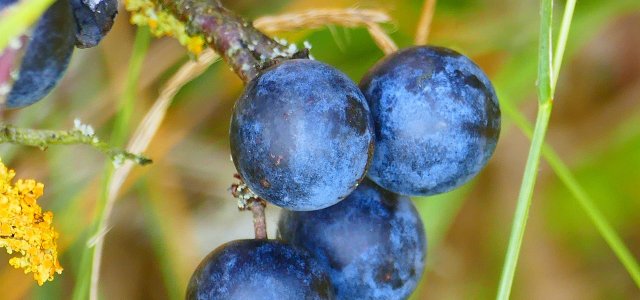
Blackthorn is a native hedge. It provides a safe breeding place for birds and provides hedgehogs and many other animals with valuable food.
Blackthorn is a native shrub also known as “blackthorn”, “blackthorn” or “European acacia”. The flowers of the hedge are particularly beautiful. The fine white blossoms are shown off to excellent advantage against the dark branches.
The blackthorn is widespread in many parts of Europe and as far as Western Asia and North Africa and belongs to the rose family. It is a wild form of the plum. However, the blue fruits are much smaller and more acidic and can only be eaten in autumn, after the first night frosts. Then you can make jam from them.
Here you can read how to plant and care for the hedge. You will also learn why blackthorn is so valuable.
Contents
Blackthorn in your garden

Blackthorn reaches a height of three to five meters and branches wider and wider as it ages. So you need enough space to plant the hedge in your garden. You should also pay attention to the following tips:
Location:
- The hedge is extremely adaptable and thrives in a wide variety of places.
- An optimal location is warm and sunny. However, the hedge will also do well in cooler and shadier places.
Soil:
- A nutrient-rich, calcareous loam soil is best.
- Since blackthorn can also cope with dry, hard soils, the hedge is also suitable for initial planting, as a so-called pioneer shrub.
- The soil should be well-drained in any case, as the plant is sensitive to waterlogging.
Plant and care for blackthorn
You can buy young blackthorn in well-stocked garden stores or in nurseries. The young hedge should be planted in your garden as soon as possible.
This is how you do it:
- It is best to plant blackthorn in the fall.
- Cut off dead or injured parts of the plant. This will give the healthy parts more nutrients.
- Loosen the soil thoroughly and enrich it with mature compost and a little lime to create optimal conditions for the blackthorn. For this you can also collect eggshells, crumble them and work them into the soil.
- Dig a hole where the roots of the hedge will fit.
- Now plant the blackthorn in the hole and cover the roots with soil.
Tips:
- If you want to plant a dense hedge, you should keep a distance of about two meters between each plant. If you want the blackthorn to stand on its own, you must maintain a distance of at least three meters from surrounding plants.
- The roots of the blackthorn spread strongly. In small gardens, a root barrier can be useful.
How to care for blackthorn:
- Blackthorns are extremely hardy and, as a native hedge, are well adapted to our climatic conditions. Therefore, they do not require special care or fertilization.
- If the summers are not exceptionally dry, you will hardly have to water the hedge.
- If you wish, you can cut back the blackthorn immediately after flowering. This way you can shape it into the desired form.
That is why the blackthorn is so valuable
Because as a native hedge, the blackthorn has an enormous ecological value.
The first flowers open as early as the end of March, even before the leaves sprout. They are a valuable source of food for bees, wild bees, bumblebees and other insects. The shrub is particularly popular among butterflies. Many rare species use it to lay their eggs on. Therefore, blackthorn is excellent for an insect-friendly garden.
The thorns of the shrub may be off-putting to gardeners, while many animals such as birds and hedgehogs find a protected home in it. Starting in the fall, the ripe fruit will attract even more birds. If you are lucky, you may see blackbirds, robins or wrens at the blackthorn.
Planting blackthorn in your garden can help animals and insects. Blackthorn can help to counteract insect mortality and create refuges for native animals.

